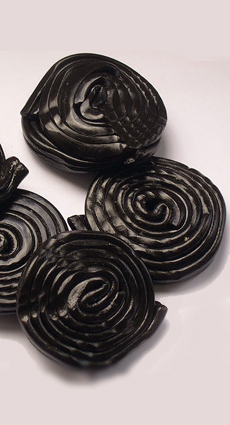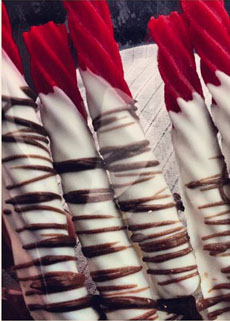FOOD FUN: Chocolate Covered Licorice
|
Here’s a fun idea we found on the Red Vines Facebook page: red licorice enrobed in white chocolate, drizzled with dark chocolate.
You can make them for Halloween. Simply melt white chocolate, dip licorice and dry on wax paper. When white chocolate has dried, drizzle with milk chocolate (use a squeeze bottle). Licorice is a “healthier candy”: no cholesterol, no salt. Few Americans have grown up without sampling bags of Twizzlers or licorice ropes. But it started out as medicine! THE HISTORY OF LICORICE |
A “twist” on conventional licorice. Photo courtesy Red Vines. |
|
|
Use of licorice has been documented for 3,000 years. Ancient Egyptians created a sweet drink from it. Large quantities of licorice root were found in the tomb of King Tut (1356 to 1339 B.C.E.) A popular version of the drink, called mai sus, is still enjoyed in Egypt. The Caesars advocated licorice as a health remedy. Some 1800 years later, Napoleon Bonaparte chewed licorice for his ongoing digestive problems. Over time, his teeth turned black from the concentration of licorice juice. (You can chew on a piece of licorice root if you want the experience —just don’t make a habit of it.) Licorice extract is made from the root of the licorice plant, Glycyrrhiza glabra. A member of the pea family that is native to southeastern Europe, licorice grows about four feet high with pretty bluish purple and white flowers that resemble sweet pea blossom. Although they have similar flavor notes, licorice is not related to the spices anise and star anise, the vegetable fennel or the spice tarragon. The relation is that all of these plants and spices contain anethole, an aromatic and sweet-tasting ether compound. |
||
 Black licorice wheels. Photo by Pikaluk | Wikimedia. |
To make licorice extract or syrup, the dried root is boiled in water; then most of the water is evaporated. In addition to health remedies and confections, licorice is used in cooking to flavor broths, herbal teas, liqueur and soft drinks. The root can be chewed as a breath freshener. Before the widespread availability of affordable sugar, licorice was used as a sweetener (glycyrrhizin, a component of licorice, is 50 times sweeter than table sugar but also carries with it the strong licorice flavor). LICORICE FACTS |
|
|
LICORICE AS A CONFECTION At some point, licorice, sweetened with honey or sugar, took on a new purpose: candy. While licorice extract continued to be used for medicinal purposes, its sweet chewiness made it a popular treat. WHY IS LICORICE PRONOUNCED LICORISH? The Scots pronounce it “licoriss,” from the Old French “licoresse.” In England and the U.S., it is “licorish.” Here are two theories as to why:
|
||



